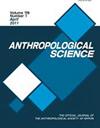拇掌指关节的芝麻状结构与人类手的进化
IF 0.8
4区 社会学
Q3 EVOLUTIONARY BIOLOGY
引用次数: 1
摘要
掌指关节的籽状骨是位于掌板上的小骨,与掌骨头相连。几乎所有人类的掌指关节都有桡骨和尺骨籽状骨。这些骨骼保护并引导长(=外源性)政治屈肌的肌腱。虽然这种情况被认为是灵长类动物的原始状态,但现存的类人猿有失去这些政治种子的倾向。苏斯曼(Science 1994;265: 1570-1573)将现存类人猿的政治籽状体的丧失与政治屈肌长肌腱的显著减少/丧失联系起来。然而,这些政治芝麻在黑猩猩中的流行程度在以前的研究中有很大的不同。因此,我们对12只黑猩猩、4只大猩猩和2只猩猩的尸体进行了ct扫描,并研究了这些类人猿掌指关节籽状体的频率。将我们的研究结果与先前报道的数据相结合,得出黑猩猩(n = 24)的更新频率为21%,大猩猩(n = 7)和猩猩(n = 6)的更新频率为0%。这一结果与先前声称的类人猿肢外屈肌腱独立减少(或丧失)一致(Diogo等人,Journal of Human Evolution 2012;63: 64-78),并强调了现存的类人猿独立地失去了这种肌腱-籽复合体的观点。考虑到类人猿外在政治屈肌肌腱的减少(或丧失)是强调钩握和政治减少之间的权衡,人类的手没有经历过钩握的专门化,在这方面保持了原始状态。红毛猩猩和黑猩猩各自擅长抓钩。大猩猩的情况是模棱两可的,它们的手的比例与人类相似。大猩猩的手可能是次要达到他们现在的状态,或者他们可能失去了强大的外部屈肌的pollex的原因,而不是专门的钩握。本文章由计算机程序翻译,如有差异,请以英文原文为准。
Sesamoids of the pollical metacarpophalangeal joint and the evolution of hominoid hands
Sesamoids of the metacarpophalangeal joint are tiny bones located in the volar plate and articulated with the metacarpal head. Almost all living humans have radial and ulnar sesamoids in their pollical metacarpophalangeal joints. These bones protect and guide the tendon of the long (= extrinsic) pollical flexor. Whereas this condition is considered to be primitive for primates, living great apes have a tendency to lose these pollical sesamoids. Susman (Science 1994; 265: 1570–1573) correlated the loss of the pollical sesamoids in living great apes with the remarkable reduction/loss of the tendon of the long pollical flexor. However, the prevalence of these pollical sesamoids in chimpanzees drastically differs among previous studies. Thus, we CT-scanned cadavers of 12 chimpanzees, four gorillas, and two orangutans, and investigated the frequency of pollical metacarpophalangeal joint sesamoids in these apes. Combining our findings with previously reported data gave updated frequencies of 21% in chimpanzees ( n = 24) and 0% in gorillas ( n = 7) and orangutans ( n = 6). This result is in accordance with the purport-ed independent reduction (or loss) of the tendon of extrinsic flexor of the pollex in great apes (Diogo et al., Journal of Human Evolution 2012; 63: 64–78) and underscores the view that living great apes independently lost this tendon–sesamoid complex. Given that a reduction (or loss) of the tendon of extrinsic pollical flexor in great apes is a trade-off between emphasis on hook grips and pollical reduction, human hands have not experienced specialization for hook grips and retain the primitive condition in this re-gard. Orangutans and chimpanzees independently specialized for hook grips. The case for gorillas, whose hand proportion is similar to that of humans, is equivocal. Gorilla hands may have attained their current state secondarily or they may have lost the powerful extrinsic flexor of the pollex for reasons other than specialized hook grips.
求助全文
通过发布文献求助,成功后即可免费获取论文全文。
去求助
来源期刊

Anthropological Science
生物-进化生物学
CiteScore
1.50
自引率
0.00%
发文量
7
审稿时长
>12 weeks
期刊介绍:
Anthropological Science (AS) publishes research papers, review articles, brief communications, and material reports in physical anthropology and related disciplines. The scope of AS encompasses all aspects of human and primate evolution and variation. We welcome research papers in molecular and morphological variation and evolution, genetics and population biology, growth and development, biomechanics, anatomy and physiology, ecology and behavioral biology, osteoarcheology and prehistory, and other disciplines relating to the understanding of human evolution and the biology of the human condition.
 求助内容:
求助内容: 应助结果提醒方式:
应助结果提醒方式:


